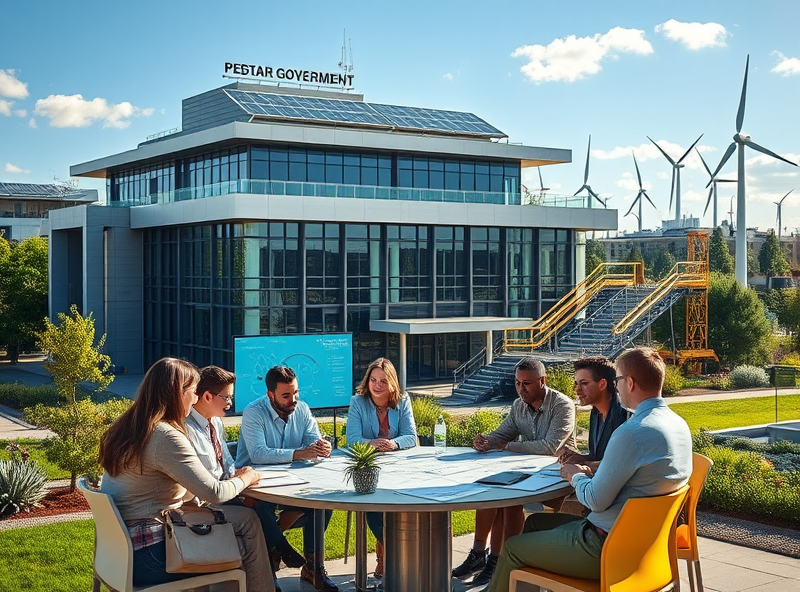
Green Growth: Future Power of the Global Economy

Hello, forward-thinking readers! Have you noticed how conversations about the economy and the environment are becoming more and more connected? It seems like every day we hear about climate change, renewable energy, and the need for more sustainable ways of living and doing business. For a long time, it felt like we had to choose between economic growth and protecting the planet – that one came at the expense of the other. But what if there was a way to achieve both? What if building a healthier planet could actually be a powerful engine for future economic prosperity? This is the exciting idea behind “Green Growth.” It’s a concept that suggests we can continue to grow our economies, create jobs, and improve living standards, but do so in a way that is environmentally sustainable. You might wonder, “Is green growth truly possible?” or “How can environmental efforts actually boost the economy?” You’re asking questions that are shaping the future of global economics! The purpose of this article is to explore the concept of green growth, delve into its potential as a future power of the global economy, and discuss the opportunities and challenges involved. Let’s discover how a focus on sustainability can unlock new avenues for innovation, investment, and prosperity worldwide.
Defining Green Growth: A New Economic Paradigm
Green growth is an economic strategy that aims to foster economic growth and development while ensuring that natural assets continue to provide the resources and environmental services on which our well-being relies. It’s about decoupling economic growth from environmental degradation. In traditional economic models, growth often came hand-in-hand with increased resource consumption, pollution, and environmental damage. Green growth seeks to break this link. It’s not about stopping growth; it’s about changing the *quality* of growth. It means pursuing economic activities that are resource-efficient, low-carbon, resilient to environmental risks, and socially inclusive. It recognizes that a healthy environment is not a barrier to prosperity, but rather a foundation for long-term economic stability and opportunity. It’s a shift in thinking, viewing environmental protection and economic progress as mutually reinforcing goals, not conflicting ones.
The Urgent Imperative for Green Growth
Why is green growth becoming so essential right now? The answer lies in the pressing environmental challenges we face globally. Climate change, driven largely by greenhouse gas emissions from burning fossil fuels, poses significant risks to economies through extreme weather events, rising sea levels, and disruptions to agriculture and ecosystems. Resource depletion – the finite nature of fossil fuels, minerals, and even fresh water – highlights the need for more efficient resource use and the transition to renewable alternatives. Pollution of air, water, and soil has direct costs on public health and ecosystems, impacting productivity and quality of life. Biodiversity loss weakens the natural systems that provide essential services to our economies. Continuing with a traditional “brown” growth model, which relies heavily on unsustainable resource use and generates significant pollution, is simply not viable in the long term. It creates risks that can undermine economic stability and future prosperity. Green growth is therefore not just an environmental choice; it’s an economic necessity for building resilient and sustainable economies that can thrive in the 21st century and beyond.
Key Pillars Driving the Green Economy
Achieving green growth requires fundamental shifts across various sectors of the economy. Several key pillars underpin this transition:
- Renewable Energy Transition: Shifting from fossil fuels (coal, oil, natural gas) to renewable sources like solar, wind, hydro, and geothermal power is central to reducing greenhouse gas emissions and creating a sustainable energy system. This involves massive investment in renewable energy infrastructure, storage solutions, and grid modernization.
- Energy Efficiency: Using less energy to achieve the same outcome is a powerful way to reduce environmental impact and save costs. This includes improving the energy efficiency of buildings, transportation, industrial processes, and appliances.
- Sustainable Transportation: Moving towards electric vehicles, improving public transportation, developing sustainable aviation fuels, and promoting cycling and walking are crucial for reducing emissions from the transport sector.
- Circular Economy Principles: Moving away from a linear “take-make-dispose” model to a circular economy involves designing products for durability, reuse, repair, and recycling. This reduces waste, conserves resources, and creates new business opportunities in repair, remanufacturing, and recycling industries.
- Green Technologies and Innovation: Developing and deploying new technologies is vital for green growth. This includes advancements in renewable energy, energy storage, carbon capture, sustainable materials, smart grids, and environmental monitoring. Innovation is the engine that makes green solutions more effective and affordable.
- Sustainable Agriculture and Land Use: Adopting farming practices that reduce environmental impact, conserve water, improve soil health, and protect biodiversity is essential. Sustainable forestry and land management also play a critical role in carbon sequestration and ecosystem health.
- Green Finance and Investment: Directing financial flows towards environmentally sustainable projects and businesses is crucial. This includes green bonds, sustainable investment funds, and integrating ESG (Environmental, Social, Governance) factors into investment decisions.
- Supportive Government Policies: Governments play a critical role in creating the right conditions for green growth through policies like carbon pricing, subsidies for clean energy, regulations on pollution, investment in green infrastructure, and support for green R&D.
These pillars are interconnected and require coordinated action across governments, businesses, and individuals.
Economic Opportunities Unlocked by Green Growth
The transition to a green economy is not just about mitigating risks; it’s also about seizing significant economic opportunities. This transition is creating new industries, markets, and jobs:
- Job Creation: The green economy is a significant source of new employment, often referred to as “green jobs.” These jobs span a wide range of sectors, including manufacturing and installing solar panels and wind turbines, building energy-efficient homes, developing and maintaining electric vehicle infrastructure, working in recycling and waste management, and providing environmental consulting services. While some jobs in traditional industries may decline, the growth in green sectors has the potential to create a net increase in employment and offer new career paths.
- New Industries and Markets: The demand for sustainable products and services is growing rapidly. This is creating entirely new industries, such as renewable energy generation, energy storage, green building materials, sustainable fashion, and plant-based foods. Companies that innovate and position themselves in these emerging markets can tap into significant growth potential.
- Increased Competitiveness and Innovation: Companies that embrace green practices can gain a competitive edge. Investing in energy efficiency can lower operating costs. Developing sustainable products can attract environmentally conscious consumers. Focusing on innovation in green technologies can lead to new patents and market leadership. Green growth encourages businesses to be more efficient, innovative, and responsive to evolving consumer and regulatory demands.
- Resource Efficiency and Cost Savings: By using resources more efficiently, reducing waste, and adopting cleaner production processes, businesses can lower their input costs and improve profitability. This is a direct economic benefit of green practices.
- Attracting Investment: As mentioned earlier, investors are increasingly looking at ESG factors. Companies with strong environmental performance and clear sustainability strategies are often more attractive to investors, potentially leading to lower capital costs and higher valuations. The growth of green finance is directing significant capital towards sustainable projects and companies.
- Improved Public Health and Productivity: Reducing pollution leads to better air and water quality, which improves public health. A healthier population means lower healthcare costs and increased productivity in the workforce. These are significant economic benefits that result from environmental improvements.
Viewing green growth through an economic lens reveals that it’s not just an expense, but a powerful driver of innovation, efficiency, and new market creation.
Navigating the Challenges of Transition
While the vision of green growth is compelling, the transition is not without its challenges. Moving from a fossil fuel-dependent economy to a sustainable one requires significant effort and investment:
- Initial Investment Costs: Building new renewable energy infrastructure, upgrading buildings for energy efficiency, or developing new green technologies often requires substantial upfront investment. While these investments can lead to long-term savings and returns, the initial capital requirement can be a barrier.
- Policy Implementation Challenges: Designing and implementing effective government policies to support green growth can be complex. Policies like carbon pricing need careful consideration to avoid unintended consequences. Balancing environmental goals with economic competitiveness is an ongoing challenge for policymakers.
- Need for Workforce Retraining: As some traditional industries decline, workers may need to acquire new skills to find employment in green sectors. Investing in education and training programs is crucial to ensure a just transition for workers and communities.
- Potential Resistance from Established Industries: Industries heavily invested in fossil fuels or other unsustainable practices may resist the transition due to concerns about stranded assets or changes to their business models.
- International Cooperation: Addressing global challenges like climate change requires international cooperation on emissions reductions, technology transfer, and financial support, which can be challenging to coordinate across different countries with varying levels of development and priorities.
- Ensuring Equity and Inclusivity: The benefits and costs of the green transition must be distributed equitably. Policies need to be designed to support vulnerable communities and ensure that green growth benefits everyone, not just a select few.
Acknowledging and proactively addressing these challenges through smart policies, public-private partnerships, and investment in people is essential for a successful and smooth transition to a green economy.
Conceptual Examples of Green Growth in Action
We can see the principles of green growth being applied in various ways around the world (without needing specific company names or detailed data points):
- Growth in Renewable Energy Capacity: Countries are rapidly increasing their capacity to generate electricity from solar and wind power. This involves building large solar farms and wind parks, as well as installing rooftop solar panels on homes and businesses. This creates jobs in manufacturing, installation, and maintenance.
- Expansion of Electric Vehicle Market: The automotive industry is shifting towards electric vehicles (EVs). This is driving innovation in battery technology, creating jobs in EV manufacturing, and requiring the build-out of charging infrastructure.
- Investment in Green Infrastructure: Cities and governments are investing in sustainable public transportation systems, energy-efficient buildings, smart grids, and green spaces. These projects create jobs and improve the quality of life while reducing environmental impact.
- Development of Circular Economy Initiatives: Businesses are exploring ways to design products that can be easily recycled or reused, setting up systems for collecting and processing waste materials, and developing new business models based on repair and remanufacturing.
- Sustainable Agriculture Practices: Farmers are adopting techniques like precision agriculture, cover cropping, and reduced tillage to improve soil health, conserve water, and reduce the need for chemical inputs.
These examples illustrate that green growth is not just a theoretical concept; it’s happening now, driven by innovation, investment, and changing policies.
The Critical Role of Policy and Investment
Government policies are crucial catalysts for green growth. Clear, consistent, and long-term policy signals provide certainty for businesses and investors, encouraging them to invest in green technologies and practices. Policies like carbon pricing (e.g., carbon taxes or cap-and-trade systems) can make polluting activities more expensive, incentivizing emissions reductions. Subsidies or tax credits for renewable energy and energy efficiency can help make green alternatives more competitive. Investing public funds in basic research and development for green technologies can drive innovation. Furthermore, integrating environmental considerations into financial regulations and promoting green finance can help channel private investment towards sustainable projects. Public investment in green infrastructure, like modernizing the electricity grid to handle renewable energy or building charging stations for EVs, is also essential to enable the transition. A supportive policy environment is key to unlocking the full potential of green growth.
Your Part in Building the Green Future
As individuals, we also have a role to play in fostering green growth. Our choices as consumers can drive demand for sustainable products and services. Supporting businesses that prioritize environmental and social responsibility sends a powerful market signal. As investors, we can choose to direct our money towards companies and funds that are aligned with green growth principles, such as ESG funds or funds focused on renewable energy or clean technology. By integrating sustainability into our financial decisions, we can contribute to the growth of the green economy and potentially benefit from the opportunities it creates. Educating ourselves and engaging in conversations about green growth can also help build broader support for the necessary policies and investments.
Green Growth: A Path to a Prosperous and Sustainable Future
In conclusion, green growth represents a vital new paradigm for the global economy, seeking to achieve economic prosperity while ensuring environmental sustainability. It is driven by the urgent need to address challenges like climate change and resource depletion, and it is powered by innovation, policy, and investment in areas like renewable energy, energy efficiency, and the circular economy. While the transition presents challenges, the economic opportunities it unlocks – including job creation, new industries, increased competitiveness, and improved public health – are significant. Green growth is not just an environmental imperative; it is increasingly recognized as a powerful engine for future economic value creation. By understanding the principles of green growth, supporting supportive policies, and considering sustainable options in our own consumption and investment decisions, we can all play a part in building a more prosperous and sustainable future for ourselves and for generations to come. Embrace the potential of the green economy and explore how you can be a part of this transformative journey. Wishing you insight, opportunity, and a commitment to a sustainable future! 😊







